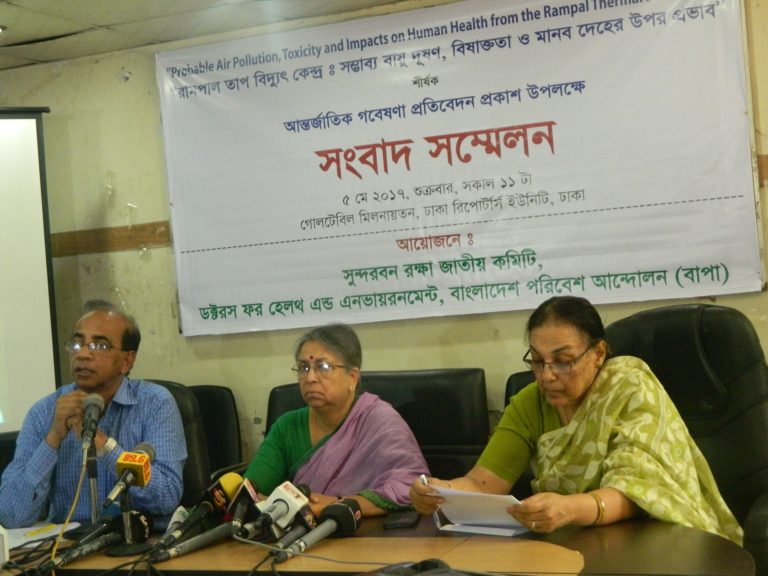Rampal Thermal Power Plant: Potential Air Pollution, Toxicity and Effects on Human Health
By: Waterkeeper Alliance

A press conference was held for the publication of international research report titled as “Rampal Thermal Power Plant: Potential Air Pollution, Toxicity and Effects on Human Health” in the roundtable room of Dhaka Reporters Unity at 5:00 am on Friday, May 5, 017. It was organized jointly by the National Committee for Saving the Sundarbans (NCSS), Doctors for Health and Environment and Bangladesh Poribesh Andolon (BAPA). The meeting was presided over by Advocate Sultana Kamal, Convener of NCSS, while Lauri Myllyvirta, Coal and Air Pollution Specialist of Greenpeace, presented his study. Pediatrician and President of Doctor for Health Professor Dr. Nazmun Nahar, Health Researcher Dr. M Abu Sayeed and Member Secretary of the National Committee for Saving the Sundarbans & General Secretary of BAPA Dr. Mohd. Abdul Matin and BAPA Joint Secretary Sharif Jamil spoke in the press conference.
By presenting his research paper, Lauri Myllyvirta said that the proposed 1320 MW coal-based power plant in Rampal will be one of the largest single sources of air pollution throughout Bangladesh. The source of the power plant will increase the air toxicity level in the Sundarbans’ ecosystem including the entire south-west of Bangladesh and Khulna, Ashoknagar, Kalyangar, Satkhira, Begumganj, Bashirhat, Narsingdi, Noakhali, Basipur and Comilla regions. Residents of Dhaka and Calcutta, especially children and old people, will be severely affected by the air pollution. He said that the emission of power plants throughout the working hours – will increase the risk of stroke, lung cancer, cardiovascular and respiratory diseases for adults, as well as children. Even if the current air pollution level of Bangladesh is zero, the power plant alone will cause premature death of 6,000 people and the low birth weight of 24,000 children. The day hours will impact the highest and the average Nitrogen oxide levels of the surrounding air will increase up to 25% of the current city’s average, and Sulfur dioxide levels will increase up to 50%. He also mentioned that the high density of population in this region and the weak management of emission system will be the cause for more harmful health effects. The tender has five to ten times more emission of Sulfur dioxide, Nitrogen oxide, dust and mercury than the standard level and state-of-art technology emission level. The power plant can emit strong harmful nerve poison named Mercury, which can damage the brain and the nerve-system of children. Mercury emission from Rampal Power Plant will be sufficient enough to make the fish residing around 70 square kilometers non-edible. These highly affected areas are completely submerged in the Sundarbans wetlands. In addition, during the lifetime of the plant, 10,000 kg of mercury will be deposited as coal ash in ponds which will later be carried away by flood. The extra mercury will cause more damage to the aquatic food-cycle of the Sundarbans and the Bay of Bengal, which will affect millions of people feeding on those fishes.
Advocate Sultana Kamal said that coal-based projects considering environmental and humanitarian grounds can never be accepted, which is already proven by multiple international research works. She informed that they have repeatedly provided science-based facts, but the government has not taken any of these issues into consideration, rather it is going to implement such a potentially harmful project with false information. Referring to the plant builder company MD’s clear denial of using ultra super critical technology in the plant, Sultana Kamal said that as such there had been no adequately effective measures taken yet to combat such pollutions. The government’s EIA report on this project is not based on science and there is no transparency there, and they have already rejected it. She said that she does not possess any personal interests or conflicts. Only in the interests of protecting the Sundarbans, the environment and the nation, she was speaking against the Rampal project with valid scientific information and facts.
Professor Dr. Nazmun Nahar said that on one hand, medical science has been making continuous efforts to reduce child mortality and has been achieving many successes. On the other hand, due to the possible pollution from the Rampal project, 6,000 children will die prematurely and 24,000 children will be born with less weight, whose large part will be the burden of the society due to their disability. In our country, 48% of children are born with low weight because of the environmental crisis and their mothers’ unhealthy diet. We will lag behind in the children’s health parameter when the victims of Rampal’s will be added. Pregnant mothers are very dependent on fish and vegetables, but they contain formalin or harmful chemicals. Scientific data shows that, if the Rampal project is implemented, its toxicity will not only affect the nearby sea, river and soil, but also a vast area of Bangladesh. It will also disperse toxic chemicals in fish and vegetables. In the future, there is a possibility for increment of not only low weight but disable babies.
Professor Dr. M Abu Sayeed said, by the influence of Rampal project, soil, water and air pollution will increase affecting the public health of the country. Due to Mercury and other pollutants’ emission from this project, children will possess under-developed brains which will cause many physical and psychological problems. Therefore, Rampal Project must be abandoned.